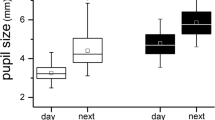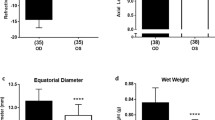Abstract
Purpose
To investigate the effects of the relatively selective GABAAOr receptor antagonist (1,2,5,6-tetrahydropyridin-4-yl) methylphosphinic acid (TPMPA) on form-deprivation myopia (FDM) in guinea pigs.
Methods
A diffuser was applied monocularly to 30 guinea pigs from day 10 to 21. The animals were randomized to one of five treatment groups. The deprived eye received daily sub-conjunctival injections of 100 μl TPMPA at a concentration of (i) 0.03 %, ( ii) 0.3 %, or (iii) 1 %, a fourth group (iv) received saline injections, and another (v) no injections. The fellow eye was left untreated. An additional group received no treatment to either eye. Prior to and at the end of the treatment period, refraction and ocular biometry were performed.
Results
Visual deprivation produced relative myopia in all groups (treated versus untreated eyes, P < 0.05). The amount of myopia was significantly affected by the drug treatment (one-way ANOVA, P < 0.0001); myopia was less in deprived eyes receiving either 0.3 % or 1 % TPMPA (saline = −4.38 ± 0.57D, 0.3 % TPMPA = −3.00 ± 0.48D, P < 0.01; 1 % TPMPA = −0.88 ± 0.51D, P < 0.001). The degree of axial elongation was correspondingly less (saline = 0.13 ± 0.02 mm, 0.3 % TPMPA = 0.09 ± 0.01 mm, P < 0.01, 1 % TPMPA = 0.02 ± 0.01 mm, P < 0.001) as was the VC elongation (saline = 0.08 ± 0.01 mm, 0.3 % TPMPA = 0.05 ± 0.01 mm, P < 0.01, 1 % TPMPA = 0.01 ± 0.01 mm; P < 0.001). ACD and LT were not affected (one-way ANOVA, P > 0.05). One percent TPMPA was more effective at inhibiting myopia than 0.3 % (P < 0.01), and 0.03 % did not appreciably inhibit the myopia (0.03 % TPMPA versus saline, P > 0.05).
Conclusions
Sub-conjunctival injections of TPMPA inhibit FDM in guinea pig models in a dose-dependent manner.



Similar content being viewed by others
Abbreviations
- TPMPA:
-
(1,2,5,6-tetrahydropyridin-4-yl) methylphosphinic acid
- FDM:
-
Form-deprivation myopia
- SER:
-
Spherical equivalent refraction
- AL:
-
Axial length
- VCD:
-
Vitreous chamber depth
- ACD:
-
Anterior chamber depth
- LT:
-
Lens thickness
- RPE:
-
Retinal pigment epithelium.
References
Ragozzino D, Woodward RM, Murata Y et al (1996) Design and in vitro pharmacology of a selective gamma-aminobutyric acidC receptor antagonist. Mol Pharmacol 50:1024–1030
Olsen RW, Sieghart W (2008) International Union of Pharmacology. LXX. Subtypes of gamma-aminobutyric acid(A) receptors: classification on the basis of subunit composition, pharmacology, and function. Update. Pharmacol Rev 60:243–260
Stone RA, Liu J, Sugimoto R et al (2003) GABA, experimental myopia, and ocular growth in chick. Invest Ophthalmol Vis Sci 44:3933–3946
Schmid KL, Strasberg G, Rayner CL, Hartfield PJ (2013) The effects and interactions of GABAergic and dopaminergic agents in the prevention of form deprivation myopia by brief periods of normal vision. Exp Eye Res 110:88–95
Redburn-Johnson D (1998) GABA as a developmental neurotransmitter in the outer plexiform layer of the vertebrate retina. Perspect Dev Neurobiol 5:261–267
Calaza KC, Gardino PF, de Mello FG (2006) Transporter mediated GABA release in the retina: role of excitatory amino acids and dopamine. Neurochem Int 49:769–777
Yang XL (2004) Characterization of receptors for glutamate and GABA in retinal neurons. Prog Neurobiol 73:127–150
Cheng ZY, Chebib M, Schmid KL (2011) rho1 GABAC receptors are expressed in fibrous and cartilaginous layers of chick sclera and located on sclera fibroblasts and chondrocytes. J Neurochem 118:281–287
Cheng ZY, Chebib M, Schmid KL (2012) Identification of GABA receptors in chick cornea. Mol Vis 18:1107–1114
Cheng ZY, Wang XP, Schmid KL, Liu L (2013) Identification of GABA receptors in chick retinal pigment epithelium. Neurosci Lett 539:43–47
Seigel GM, Sun W, Salvi R et al (2003) Human corneal stem cells display functional neuronal properties. Mol Vis 9:159–163
Booij JC, ten Brink JB, Swagemakers SM et al (2010) A new strategy to identify and annotate human RPE-specific gene expression. PLoS ONE 5:e9341
Guo C, Hirano AA, Stella SL Jr et al (2010) Guinea pig horizontal cells express GABA, the GABA-synthesizing enzyme GAD 65, and the GABA vesicular transporter. J Comp Neurol 518:1647–1669
Oh SJ, Kim IB, Lee EJ et al (1999) Immunocytological localization of dopamine in the guinea pig retina. Cell Tissue Res 298:561–565
Osborne NN, Patel S, Beaton DW, Neuhoff V (1986) GABA neurones in retinas of different species and their postnatal development in situ and in culture in the rabbit retina. Cell Tissue Res 243:117–123
Biedermann B, Bringmann A, Reichenbach A (2002) High-affinity GABA uptake in retinal glial (Muller) cells of the guinea pig: electrophysiological characterization, immunohistochemical localization, and modeling of efficiency. Glia 39:217–228
Biedermann B, Eberhardt W, Reichelt W (1994) GABA uptake into isolated retinal Muller glial cells of the guinea-pig detected electrophysiologically. Neuroreport 5:438–440
Howlett MH, McFadden SA (2006) Form-deprivation myopia in the guinea pig (Cavia porcellus). Vision Res 46:267–283
Chen BY, Wang CY, Chen WY, Ma JX (2013) Altered TGF-beta2 and bFGF expression in scleral desmocytes from an experimentally-induced myopia guinea pig model. Graefes Arch Clin Exp Ophthalmol 251:1133–1144
McFadden SA, Gambrill R, Leotta AJ, Bowrey HE, Zeng G (2011) Inhibition of GABAc slows ocular growth and myopia in the mammalian eye. Invest Ophthalmol Vis Sci 52: E-Abstract 6306.
Edwards MH (1996) Animal models of myopia. A review. Acta Ophthalmol Scand 74:213–219
Pardue MT, Stone RA, Iuvone PM (2013) Investigating mechanisms of myopia in mice. Exp Eye Res 114:96–105
Gao Q, Liu Q, Ma P et al (2006) Effects of direct intravitreal dopamine injections on the development of lid-suture induced myopia in rabbits. Graefes Arch Clin Exp Ophthalmol 244:1329–1335
Smith EL 3rd, Hung LF, Arumugam B (2014) Visual regulation of refractive development: insights from animal studies. Eye (Lond) 28:180–188
McBrien NA, Moghaddam HO, Reeder AP (1993) Atropine reduces experimental myopia and eye enlargement via a nonaccommodative mechanism. Invest Ophthalmol Vis Sci 34:205–215
Stone RA, Pardue MT, Iuvone PM, Khurana TS (2013) Pharmacology of myopia and potential role for intrinsic retinal circadian rhythms. Exp Eye Res 114:35–47
Barathi VA, Beuerman RW (2011) Molecular mechanisms of muscarinic receptors in mouse scleral fibroblasts: prior to and after induction of experimental myopia with atropine treatment. Mol Vis 17:680–692
Tigges M, Iuvone PM, Fernandes A et al (1999) Effects of muscarinic cholinergic receptor antagonists on postnatal eye growth of rhesus monkeys. Optom Vis Sci 76:397–407
Chua WH, Balakrishnan V, Chan YH et al (2006) Atropine for the treatment of childhood myopia. Ophthalmology 113:2285–2291
Leech EM, Cottriall CL, McBrien NA (1995) Pirenzepine prevents form deprivation myopia in a dose dependent manner. Ophthalmic Physiol Opt 15:351–356
Le QH, Cheng NN, Wu W, Chu RY (2005) Effect of pirenzepine ophthalmic solution on form-deprivation myopia in the guinea pigs. Chin Med J (Engl) 118:561–566
Siatkowski RM, Cotter SA, Crockett RS et al (2008) Two-year multicenter, randomized, double-masked, placebo-controlled, parallel safety and efficacy study of 2 % pirenzepine ophthalmic gel in children with myopia. J AAPOS 12:332–339
McBrien NA, Arumugam B, Gentle A et al (2011) The M4 muscarinic antagonist MT-3 inhibits myopia in chick: evidence for site of action. Ophthalmic Physiol Opt 31:529–539
Arumugam B, McBrien NA (2012) Muscarinic antagonist control of myopia: evidence for M4 and M1 receptor-based pathways in the inhibition of experimentally-induced axial myopia in the tree shrew. Invest Ophthalmol Vis Sci 53:5827–5837
Feldkaemper M, Schaeffel F (2013) An updated view on the role of dopamine in myopia. Exp Eye Res 114:106–119
Li XX, Schaeffel F, Kohler K, Zrenner E (1992) Dose-dependent effects of 6-hydroxy dopamine on deprivation myopia, electroretinograms, and dopaminergic amacrine cells in chickens. Vis Neurosci 9:483–492
Rohrer B, Spira AW, Stell WK (1993) Apomorphine blocks form-deprivation myopia in chickens by a dopamine D2-receptor mechanism acting in retina or pigmented epithelium. Vis Neurosci 10:447–453
Schmid KL, Wildsoet CF (2004) Inhibitory effects of apomorphine and atropine and their combination on myopia in chicks. Optom Vis Sci 81:137–147
Dong F, Zhi Z, Pan M et al (2011) Inhibition of experimental myopia by a dopamine agonist: different effectiveness between form deprivation and hyperopic defocus in guinea pigs. Mol Vis 17:2824–2834
Iuvone PM, Tigges M, Stone RA et al (1991) Effects of apomorphine, a dopamine receptor agonist, on ocular refraction and axial elongation in a primate model of myopia. Invest Ophthalmol Vis Sci 32:1674–1677
Mao J, Liu S, Qin W et al (2010) Levodopa inhibits the development of form-deprivation myopia in guinea pigs. Optom Vis Sci 87:53–60
Chebib M, Hinton T, Schmid KL et al (2009) Novel, potent, and selective GABAC antagonists inhibit myopia development and facilitate learning and memory. J Pharmacol Exp Ther 328:448–457
Albrecht BE, Darlison MG (1995) Localization of the rho 1- and rho 2-subunit messenger RNAs in chick retina by in situ hybridization predicts the existence of gamma-aminobutyric acid type C receptor subtypes. Neurosci Lett 189:155–158
Zhou X, Ye J, Willcox MD et al (2010) Changes in protein profiles of guinea pig sclera during development of form deprivation myopia and recovery. Mol Vis 16:2163–2174
Howlett MH, McFadden SA (2009) Spectacle lens compensation in the pigmented guinea pig. Vision Res 49:219–227
Wang S, Liu S, Mao J, Wen D (2014) Effect of retinoic acid on the tight junctions of the retinal pigment epithelium-choroid complex of guinea pigs with lens-induced myopia in vivo. Int J Mol Med 33:825–832
Acknowledgments
This work was supported by a grant from the National Natural Science Foundation of China (No. 81271038), and a grant from the Department of Science and Technology of Shandong Province of China (No. ZR2012HM022) to ZYC.
Conflicts of interest
The authors have no conflict of interests to declare.
Author information
Authors and Affiliations
Corresponding author
Rights and permissions
About this article
Cite this article
Cheng, ZY., Wang, XP., Schmid, K.L. et al. Inhibition of form-deprivation myopia by a GABAAOr receptor antagonist, (1,2,5,6-tetrahydropyridin-4-yl) methylphosphinic acid (TPMPA), in guinea pigs. Graefes Arch Clin Exp Ophthalmol 252, 1939–1946 (2014). https://doi.org/10.1007/s00417-014-2765-5
Received:
Revised:
Accepted:
Published:
Issue Date:
DOI: https://doi.org/10.1007/s00417-014-2765-5




